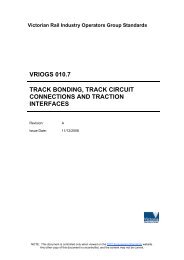VRIOGS 002.1 Railway Station Design Standard and Guidelines
VRIOGS 002.1 Railway Station Design Standard and Guidelines
VRIOGS 002.1 Railway Station Design Standard and Guidelines
Create successful ePaper yourself
Turn your PDF publications into a flip-book with our unique Google optimized e-Paper software.
<strong>VRIOGS</strong> <strong>002.1</strong> Revision A 378.6 EMERGENCY EGRESS<strong>Railway</strong> stations shall be quickly <strong>and</strong> safely evacuated during emergencies. To complywith government legislation, the design of new train stations shall meet the performancerequirements of the BCA. Each train station shall be designed to meet the performancerequirements by either satisfying the prescriptive Deemed to Satisfy (DTS) requirementsor through performance based fire engineering.The Deemed to Satisfy provisions of the BCA state that a class 9b building (whichincorporates train stations) shall not have to travel more then 60m to an emergency exit.However this would be difficult to achieve on a linear structure such as a rail platform <strong>and</strong>in general the length of escape routes for train stations do not comply with the deemed tosatisfy provisions of the BCA. Furthermore moving from one end of the platform toanother may put a person at sufficient distance from the emergency to be considered safe.Therefore, using public access paths to leave the station or relocating to other parts of theplatform, the performance outcome allowed by the building code is met.The objective of the fire safety strategy is to ensure that people can move away from apotential fire or danger. There are numerous methods to achieve this, some relying onrules governing escape routes <strong>and</strong> others emphasising evacuation time. NFPA 130 is theprimary st<strong>and</strong>ard for fire <strong>and</strong> lift safety, developed to address urban rail system, it is ast<strong>and</strong>ard specifically written to ensure safe egress from all types of railway stations. Theprincipal of the st<strong>and</strong>ard is to establish a reasonable occupant load, including both thepassengers waiting on the station <strong>and</strong> those on a train, then design enough means ofegress for that population to leave the station platform within 4 minutes in the event of anemergency. Further the st<strong>and</strong>ard requires that the ‘occupants’ should be able to escape toa ‘point of safety’ within 6 minutes.The key design aspect for the means of escape is to utilise the main entry <strong>and</strong> exit routesfor escape, not the traditional method of using separated fire isolated stairs, as would beused in a retail or commercial building. The main entry <strong>and</strong> exit points of the station areaimed at moving high volumes of people quickly. In a fire emergency, this is exactly whatis required; people to move off platforms as quickly as possible.As an extension to providing emergency egress through the use of a platform as a place ofsafety <strong>and</strong> utilising the main entry <strong>and</strong> exit points for escape, in the event that the mainentry <strong>and</strong> exit route to or from a station is impassable during an emergency an alternativeemergency egress route to a place of safety shall where possible be provided. Theprovision of an alternative emergency exit shall be assessed on a station by station basis.A risk assessment shall be undertaken <strong>and</strong> the outcome used to determine when anemergency exit is to be provided.Where emergency egress from the platform is able to be provided it shall consist of a gate,fencing <strong>and</strong> signage that meet the design <strong>and</strong> engineering requirements described inSection 9.12. Exit paths shall be easily located by people with a disability duringemergencies. Clear directional signage to enable this shall be provided.NOTE: This document is controlled only when viewed on the DOT Engineering <strong>St<strong>and</strong>ard</strong>s website. Any othercopy of this document is uncontrolled, <strong>and</strong> the content may be inaccurate.

















